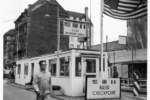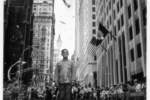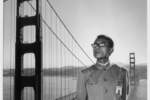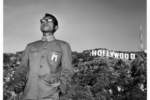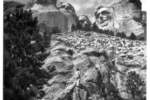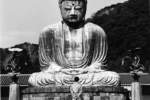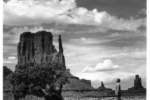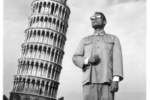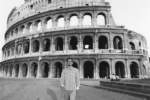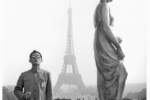Self Portrait with World Center Trade Center, 1979 Photography by Tseng Kwong Chi, © 1979 by Muna Tseng Dance Projects, Inc., New York NY. Courtesy Galleria Carla Sozzani
An unexpected event, a misunderstanding, you seem to be something you are not, and then you become it. On a distant day in 1979 Joseph Tseng became another, and was to continue to play this role for the rest of his life, which came to an untimely end in 1990 when he was only forty. The scene is that of a restaurant in Manhattan, one of the somewhat old-fashioned ones where the ”suit and tie” dress code still applies. Tseng, born in Hong Kong but the son of a soldier in the national army who had fought against the revolutionaries of Communist China, was wearing a Mao jacket and was fatally mistaken for an ambassador of the Chinese government who deserved the very best treatment, only reserved for VIPs. This banal misunderstanding, worthy of the best French pochades, was to inspire a cycle of images in black and white which Tseng began to take all over America and in the world. “East meets West” is the title of this series of photographs in which Tseng, disguised as an anonymous visitor of the Chinese government, explores, exploits and ridicules the Western stereotype of the Asiatic world. With a martial expression, Mao jacket and sunglasses, Tseng poses before the symbolic places of the American epic, in scenes that tend to cut the monumental gigantism of the architectural icons down to size: the Empire State Building, the Twin Towers, the letters forming “HOLLYWOOD” on the Californian hill, Mount Rushmore, the Golden Gate bridge in San Francisco; the monuments lose their grandiosity precisely because they are profaned in their sacredness. Tseng‘s procedure is of a both Surrealist and pop matrix. Not only does he insert an alienating element In familiar images of monuments imprinted in the collective imagery and memory, he even creates a peculiar perspective effect by superimposing, on the natural image of the architectural Icon, the artificial one of the human figure which is repeated, identical, always the same, before every Image: the result is a loss of originality, the ”decadence of the aura” and the triggering of the process of infinite reproduction typical of Pop Art. According to the transitive character of standardization, Tseng becomes an icon himself in front of these iconic landscapes: an exemplary Image, with an own sacredness. The path explored by Tseng also involves, and very profoundly, the political aspects of his art; it is sufficient to consider that the first images date from the time of Reagan, thus entering into conflict with the themes of the cold war and the new wave of anticommunism characterizing American politics in the Eighties, during the two terms of Ronald Reagan as president of the USA. Tseng opposes the diffused ignorance of Eastern culture shown every day by the Western world by a series of Ironic and alienating images which have not lost any of their provocatory charge over the years, In an attempt to explore and tell the story of a difficult interaction between individuals and cultures, by embodying the role of a paradoxical ambassador of art.



